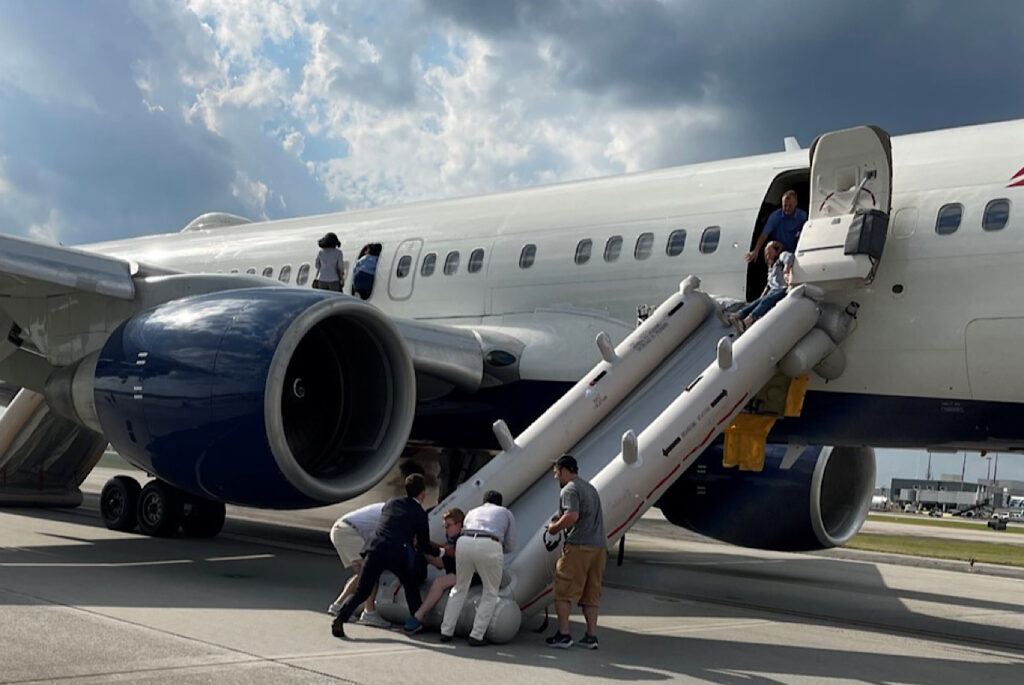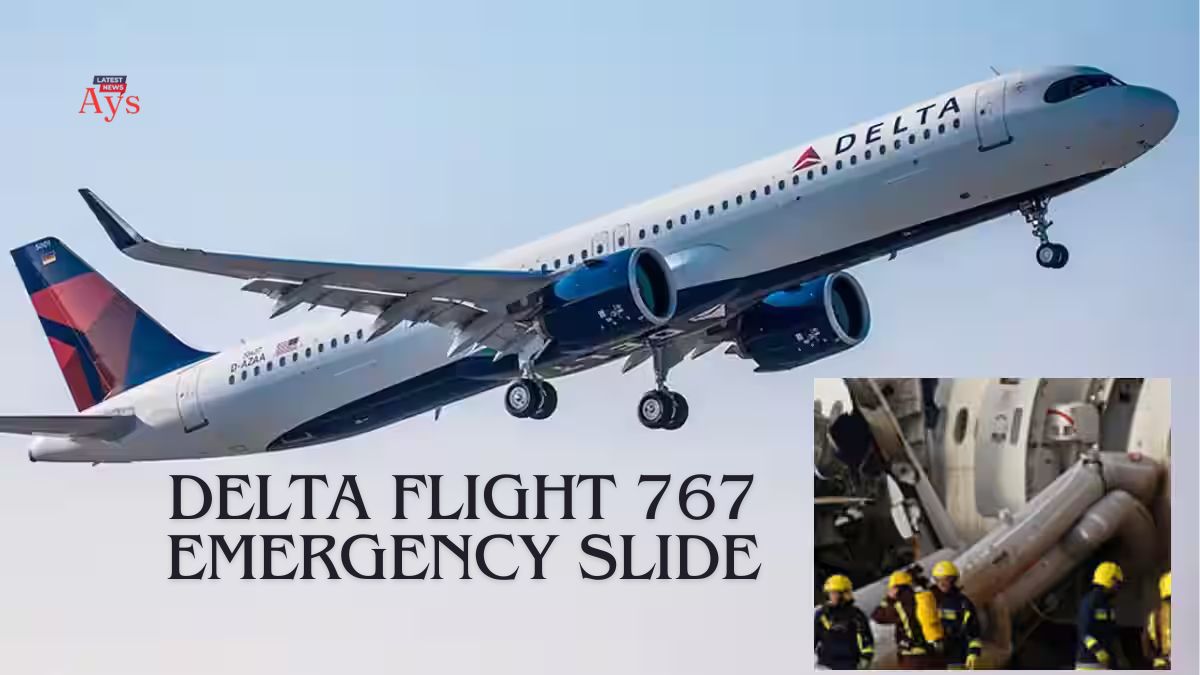Delta Flight Emergency Slide
Contents

Delta Flight Makes Safe Return After Issue with Emergency Slide
Have you ever been on a flight that had to turn around shortly after takeoff? This recently happened on a Delta flight from New York to Los Angeles, but luckily, everything turned out okay.
Here’s what went down: Passengers reported feeling vibrations and hearing strange noises shortly after the plane left the ground. The flight crew, acting swiftly and with caution, noticed a warning light related to one of the emergency exit doors. They made the decision to play it safe and return to the departure airport in New York.
Once back on the ground, airline staff discovered the source of the problem: an emergency exit slide had become detached from the plane. Thankfully, no one was hurt, and Delta got everyone on a new plane to continue their journey to LA.
This incident highlights the importance of pilot training and prioritizing safety. Even a minor issue can become a major problem in the air, so taking precautions is crucial. Delta’s crew followed protocol perfectly, ensuring a safe outcome for everyone on board.
Here are some additional points to keep in mind
- Modern airplanes are incredibly safe, and emergency procedures are practiced extensively by flight crews.
- If you ever experience something unusual on a flight, trust that the pilots are trained to handle the situation.
- The best course of action for passengers is to stay calm and follow crew instructions.
So, while this event sounds scary, it’s a good reminder of the strong safety measures in place to keep air travel reliable. The next time you board a Delta flight, you can rest assured that their top priority is getting you to your destination safely.

What is a in flight emergency?
An in-flight emergency is any situation that threatens the safety of the aircraft, passengers, or crew. There are various types, some more serious than others, but all requiring immediate attention.
- Mechanical problems: This could be anything from an engine failure to a malfunctioning landing gear.
- Loss of cabin pressure: This can happen at high altitudes if a hole develops in the fuselage.
- Medical emergency: If a passenger or crew member becomes seriously ill, the pilot may divert the plane to land as soon as possible.
- Severe weather: Encountering strong turbulence, hail, or thunderstorms can force the pilot to change course or make an emergency landing.
- Security threats: In rare cases, a hijacking or other security threat can be considered an in-flight emergency.
If an in-flight emergency occurs, the pilot will be in charge of handling the situation. They will typically follow established procedures to ensure everyone’s safety. This may involve contacting air traffic control, declaring an emergency, diverting to a different airport, or even making an emergency landing.
The most important thing for passengers to remember during an in-flight emergency is to stay calm and follow the instructions of the flight crew. They are trained to handle these situations and will do everything they can to get you safely on the ground.
Japan Plane Accident: Two planes collided on the runway during landing,
Do pilots still say Mayday?
Yes, pilots absolutely still use “Mayday” to declare a life-threatening emergency. It’s an internationally recognized distress call that gets immediate attention from air traffic control and anyone else listening on the emergency frequency.
- Life-threatening situation: This is the key factor. “Mayday” is for emergencies where there’s grave danger to the aircraft, passengers, and crew.
- Standard procedure: It’s the official way to declare such an emergency. Saying “Mayday, Mayday, Mayday” clearly communicates the urgency and helps avoid confusion.
However, there are other options for less critical situations
- Pan-Pan: This is used for urgent situations that are not life-threatening. Think of it as a call for assistance with a serious issue, but where immediate danger isn’t present.
- “Declaring an emergency”: While not the official protocol, some pilots might use this phrase, especially if English isn’t their first language.
Overall, “Mayday” remains the go-to for pilots facing dire circumstances. It’s a universally understood call to action that gets help mobilized as quickly as possible.

What is the full form of Mayday?
Mayday actually doesn’t have a full form. It was created specifically to be a clear and concise distress call that could be easily understood in any language.
The word “mayday” itself is derived from the French phrase “m’aider” which means “help me.” This origin makes it easier for people from different backgrounds to understand the urgency of the call.
Why do pilots declare Mayday?
Pilots declare Mayday to signal a life-threatening emergency to air traffic control (ATC) and anyone else monitoring the emergency frequency. It’s essentially a distress call used universally in aviation. There are two key reasons why pilots use Mayday[Delta Flight Emergency Slide]
- Immediate Attention: Mayday cuts through any ongoing radio chatter and demands immediate priority. It instantly puts ATC and everyone else on high alert, ensuring critical assistance reaches the aircraft as quickly as possible.
- Clarity and Universality: “Mayday” is a short, clear word that transcends language barriers. In the high-pressure situation of a life-threatening emergency, using a universally understood term reduces the risk of confusion and ensures everyone involved understands the gravity of the situation.
Here’s a quick recap
- Mayday indicates a dire situation: It signifies a threat to the aircraft, passengers, and crew.
- Mayday demands immediate action: It triggers a swift response from ATC and emergency services.
- Mayday is clear and universal: It cuts through language barriers for faster response.
While pilots have other options for less critical situations (like “Pan-Pan” for urgent but non-life-threatening issues), Mayday remains the definitive call for help in the face of a life-threatening emergency.[Delta Flight Emergency Slide]
Final TakeAway:
So You Heard a Bump on a Delta Flight?
Remember, even a minor quirk mid-flight can prompt a safe return, just like this Delta incident. While unexpected landings can be a hassle, they prioritize passenger safety. Think of it as a pit stop to ensure a smooth ride to your final destination.[Delta Flight Emergency Slide]
Modern airplanes are marvels of engineering, and Delta puts your safety first. So, the next time you settle into your Delta seat, buckle up, relax, and know you’re in good hands. Clear skies and happy travels![Delta Flight Emergency Slide]

